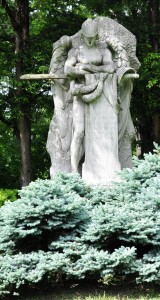
John Hay’s is one of those names from the late 19th century one recognises without quite knowing why. He deserves to be remembered. For he altered our national character.
Hay served as Secretary of State from 1898 until his death in 1905. So, he was present at the creation (pace Dean Acheson) of the American empire by Presidents McKinley and Roosevelt.
Brown University has a portrait of its distinguished alumnus painted by John Singer Sargent. It is like a high Renaissance portrait of a long-forgotten noble. Hay appears an elegant man in his 50s (the picture is undated) with a Van Dyke beard, very far from the stiff, formal portrait one might expect of a secretary of state. In Sargeant’s hands, Hay looks the captain of every drawing room, which he was.
But the overwhelming sensation is of keen intelligence.
When you go to Washington, you may pass the Hay-Adams, a hotel close by the White House. It stands where H.H. Richardson, the most important architect of the age, created two neo-Romanesque townhouses, one for John Hay (1884), the other for his great friend, Henry Adams.
Adams was certainly the great American intellectual of the 19th century, if he did not retire the title. He is one of those rarest of historians whom one reads with profit 100 years after their death. But for all the magnificence of Adams’s nine-volume history of the early republic (1889-91), Hay’s ten volumes (with John Nicolay) on Abraham Lincoln (1890) have had a greater, longer influence.
David M. Shribman, in reviewing Joshua Zeitz’s Lincoln’s Boys: John Hay, John Nicolay & the War for Lincoln’s Image (2014), quotes its author:
Americans today understand Abraham Lincoln much as Nicolay and Hay hoped they would. Theirs was a deliberate project of historical creation.
Theirs was a homage to the president they served as secretaries while in their early 20s. Of their 15-year project, Shribman says:
In repeated consultations with Lincoln’s son Robert, who would retain final editorial discretion, and with no formal historical training of their own, the two created a narrative – one that endures and defies revisionism.
…[C]omprising 1.2 million words, it was, as Zeitz puts it, “the unofficial Northern, Republican Party interpretation of the Civil War.’’
And, it lasted. Few creation myths have survived as Nicolay and Hays’s. Fewer still have served their cultures as well.
Hay married well. His wife, Clara, the daughter of Cleveland industrialist Amasa Stone, brought a fortune with her which allowed him to spend most of his career in trusted positions in government.
Unlike his friend, Henry Adams, Hay died before his wife. Adams had commissioned the great sculptor, August Saint-Gaudens, and the near-great architect, Stanford White, to construct a memorial to her. Known popularly as ‘Grief’, the Adams Memorial in Washington’s Rock Creek Cemetery is breathtaking.
Hay rests in Lake View Cemetery in Cleveland, a few yards from his father-in-law, as tragic as Hay was effortlessly successful. The statue (by James Earle Fraser) presiding over Hay’s grave is less distinguished, more modest in its setting than ‘Grief’. A picture of it accompanies this post.
Still, the Archangel Gabriel astride his memorial suggests Hay as a paladin of the reincarnated United States brought forth by the Republican Ascendency from Lincoln through Taft. John Hay’s is a name to be remembered, a life of the first order.
Recent Comments